Properties of Calcium Sulfoaluminate Cement Mortar Modified by Hydroxyethyl Methyl Celluloses with Different Degrees of Substitution
Abstract
1. Introduction
2. Materials and Methods
2.1. Raw Cement
2.2. Cellulose Ether
2.3. Proportion and Mixing
2.4. Water Retention
2.5. Consistency
2.6. Fluidity
2.7. Compressive and Flexural Strengths
2.8. Tensile Bond Strength
2.9. Dry Shrinkage Rate
2.10. MIP Analysis
3. Results and Discussion
3.1. Fresh State Properties
3.2. Hardened State Properties
3.2.1. Compressive Strength
3.2.2. Flexural Strength
3.2.3. Ratio of Compressive Strength to Flexural Strength
3.2.4. Tensile Bond Strength
3.2.5. Dry Shrinkage Rate
3.3. Pore Size Distribution and Porosity
4. Conclusions
Author Contributions
Funding
Data Availability Statement
Conflicts of Interest
Sample Availability
References
- Cai, B.; Wang, J.; He, J.; Geng, Y. Evaluating CO2 emission performance in China’s cement industry: An enterprise perspective. Appl. Energy 2016, 166, 191–200. [Google Scholar] [CrossRef]
- Xu, D.L.; Cui, Y.S.; Li, H.Y.; Kang, X.W.; Chen, Y.X. On the future of Chinese cement industry. Cem. Concr. Res. 2015, 78, 2–13. [Google Scholar] [CrossRef]
- Damtoft, J.S.; Lukasik, J.; Herfort, D.; Sorrentino, D.; Gartner, E.M. Sustainable development and climate change initiatives. Cem. Concr. Res. 2008, 38, 115–127. [Google Scholar] [CrossRef]
- Winnefeld, F.; Lothenbach, B. Hydration of calcium sulfoaluminate cements—Experimental findings and thermodynamic modelling. Cem. Concr. Res. 2010, 40, 1239–1247. [Google Scholar] [CrossRef]
- Martin, L.H.J.; Winnefeld, F.; Tschopp, E.; Müller, C.J.; Lothenbach, B. Influence of fly ash on the hydration of calcium sulfoaluminate cement. Cem. Concr. Res. 2017, 95, 152–163. [Google Scholar] [CrossRef]
- Brachaczek, W. Influence of Cellulose Ethers on the Consistency, Water Retention and Adhesion of Renovating Plasters. IOP Conf. Ser. Mater. Sci. Eng. 2019, 471, 1–9. [Google Scholar] [CrossRef]
- Cappellari, M.; Daubresse, A.; Chaouche, M. Influence of organic thickening admixtures on the rheological properties of mortars: Relationship with water-retention. Constr. Build. Mater. 2013, 38, 950–961. [Google Scholar] [CrossRef]
- Jumate, E.; Manea, D.L.; Aciu, C.; Molnar, L.; Fechete, R. Innovative Materials Made by Adding Cellulose Ethers to Cement Mortars. Procedia Technol. 2015, 19, 291–298. [Google Scholar] [CrossRef][Green Version]
- Ou, Z.H.; Ma, B.G.; Jian, S.W. Influence of cellulose ethers molecular parameters on hydration kinetics of Portland cement at early ages. Constr. Build. Mater. 2012, 33, 78–83. [Google Scholar] [CrossRef]
- Wyrzykowski, M.; Kiesewetter, R.; Kaufmann, J.; Baumann, R.; Lura, P. Pore structure of mortars with cellulose ether additions—mercury intrusion porosimetry study. Cem. Concr. Com. 2014, 53, 25–34. [Google Scholar] [CrossRef]
- Shi, C.; Zou, X.; Wang, P. Influences of ethylene-vinyl acetate and methylcellulose on the properties of calcium sulfoaluminate cement. Constr. Build. Mater. 2018, 193, 474–480. [Google Scholar] [CrossRef]
- Zhang, G.F.; He, R.; Lu, X.P.; Wang, P.M. Early hydration of calcium sulfoaluminate cement in the presence of hydroxyethyl methyl cellulose. J. Therm. Anal. Calorim. 2018, 134, 1–10. [Google Scholar] [CrossRef]
- Sun, Z.P.; Mu, F.Y.; Kang, W.; Wang, P.M.; Xu, L.L. 1H low-field NMR Relaxation Characteristics of Evaporable Water in Hydroxyethyl Methyl Cellulose Ether Modified Calcium. J. Chin. Ceram. Soc. 2019, 47, 1110–1115. [Google Scholar]
- Nguyen, D.D.; Devlin, L.P.; Koshy, P.; Sorrell, C.C. Impact of water-soluble cellulose ethers on polymer-modified mortars. J. Mater. Sci. 2014, 49, 923–951. [Google Scholar] [CrossRef]
- Ou, Z.H.; Ma, B.G.; Jian, S.W.; Shen, Y.H. Influence of Cellulose Ethers Molecular Parameters on Mechanical Properties of Cement Pastes. Bull. Chin. Ceram. Soc. 2012, 35, 2372–2377. [Google Scholar]
- Patural, L.; Marchal, P.; Govin, A.; Grosseau, P.; Ruot, B.; Devès, O. Cellulose ethers influence on water retention and consistency in cement-based mortars. Cem. Concr. Res. 2011, 41, 46–55. [Google Scholar] [CrossRef]
- Weyer, H.J.; Müller, I.; Schmitt, B.; Bosbach, D.; Putnis, A. Time-resolved monitoring of cement hydration: Influence of cellulose ethers on hydration kinetics. Nucl. Instrum. Methods Phys. Res. 2005, 238, 102–106. [Google Scholar] [CrossRef]
- Pourchez, J.; Grosseau, P.; Ruot, B. Changes in C3S hydration in the presence of cellulose ethers. Cem. Concr. Res. 2010, 40, 179–188. [Google Scholar] [CrossRef]
- Pourchez, J.; Grosseau, P.; Ruot, B. Current understanding of cellulose ethers impact on the hydration of C3A and C3A-sulphate systems. Cem. Concr. Res. 2009, 39, 664–669. [Google Scholar] [CrossRef]
- Kim, Y.S.; Kang, H.J. Effect of cellulose based water retention additives on mechanical properties of cement based mortar. Polym. Korean 2015, 39, 820–826. [Google Scholar] [CrossRef]
- Ou, Z.H.; Xiao, Y.X.; Wang, J.J.; Ma, B.G.; Jiang, L.M.; Jian, S.W. Analysis of Air Voids Evolution in Cement Pastes Admixed with Non-ionic Cellulose Ethers. J. Wuhan Univ. Technol. (Mater. Sci.) 2018, 33, 915–923. [Google Scholar] [CrossRef]
- Pourchez, J.; Grosseau, P.; Pourchez, E.R.; Debayle, J.; Parra-Denis, E. Impact of Cellulose Ethers on the Cement Paste Microstructure. In Proceedings of the 10th International Conference and Exhibition of the European Ceramic Society, Berlin, Germany, 17–21 June 2007. [Google Scholar]
- Pourchez, J.; Ruot, B.; Debayle, J.; Pourchez, E.R.; Grosseau, P. Some Aspects of Cellulose Ethers Influence on Water Transport and Porous Structure of Cement-based Materials. Cem. Concr. Res. 2010, 40, 242–252. [Google Scholar] [CrossRef]
- Müller, I. Influence of Cellulose Ethers on the Kinetics of Early Portland Cement Hydration; UniversitätKarlsruhe: Karlsruhe, Germany, 2006. [Google Scholar]
- Döbelin, N.; Kleeberg, R. Profex: A graphical user interface for the Rietveld refinement program BGMN. J. Appl. Crystallogr. 2015, 48, 1573–1580. [Google Scholar] [CrossRef]
- Carter, M.A.; Green, K.M.; Wilson, M.A.; Hoff, W.D. Measurement of the water retentivity of cement mortars. Adv. Cem. Res. 2003, 15, 155–159. [Google Scholar] [CrossRef]
- Washburn, E.W. Note on a method of determining the distribution of pore sizes in a porous material. Proc. Natl. Acad. Sci. USA 1921, 7, 115–116. [Google Scholar] [CrossRef] [PubMed]
- Phan, V.T. Relationship between the Adhesive Properties and the Rheological Behavior of Fresh Mortars; Cachan Ecole Normale Supérieure: Cachan, France, 2012. [Google Scholar]
- Zhang, Y.; Zhao, Q.; Liu, C.; Zhou, M. Properties comparison of mortars with welan gum or cellulose ether. Constr. Build. Mater. 2016, 102, 648–653. [Google Scholar] [CrossRef]
- Kumar, S.G. Influence of fluidity on mechanical and permeation performances of recycled aggregate mortar. Constr. Build. Mater. 2019, 213, 404–412. [Google Scholar] [CrossRef]
- Marta, G.M.; Angeles, G.D.L.T.; Laura, L.R.; Enrique, R.L.; Miguel, A.G.A.; Isabel, S. Effect of calcium sulfate source on the hydration of calcium sulfoaluminate eco-cement. Cem. Concr. Comp. 2015, 55, 53–61. [Google Scholar]
- Hargis, C.W.; Kirchheim, A.P.; Monteiro, P.J.M.; Ellis, M.G. Early age hydration of calcium sulfoaluminate (synthetic ye’elimite, C4A3S) in the presence of gypsum and varying amounts of calcium hydroxide. Cem. Concr. Res. 2013, 48, 105–115. [Google Scholar] [CrossRef]
- Wang, P.M.; Li, N.; Xu, L.L. Hydration evolution and compressive strength of calcium sulphoaluminate cement constantly cured over the temperature range of 0 to 80 °C. Cem. Concr. Res. 2017, 100, 203–213. [Google Scholar] [CrossRef]
- Li, L.; Wang, R.; Zhang, S. Effect of curing temperature and relative humidity on the hydrates and porosity of calcium sulfoaluminate cement. Constr. Build. Mater. 2019, 213, 627–636. [Google Scholar] [CrossRef]
- Li, Y.P.; He, R.; Chen, S.F.; Ji, S.H. Effect of Polyacrylamide and Hydroxyethyl Cellulose Ether on the Performance of the Cement Mortar. J. Wuhan Univ. Technol. 2012, 34, 28–31. [Google Scholar]
- Patural, L.; Govin, A.; Grosseau, P.; Ruot, B.; Deves, O. Influence of cellulose ether particle size on water retention of freshly-mixed mortars. In Proceedings of the ACI International Conference on Superplasticizers & Other Chemical Admixtures, Seville, Spain, 12–14 October 2009. [Google Scholar]
- Zhang, Y.S.; Li, Y.L.; Xu, J.; Zhao, H.T. Influence of cellulose ether on mortar performance. J. Build. Mater. 2008, 3, 360–362. [Google Scholar]
- Ye, H.; Radlińska, A. Shrinkage mechanisms of alkali-activated slag. Cem. Concr. Res. 2016, 88, 126–135. [Google Scholar] [CrossRef]
- Liang, S.J. Study on the Relationship between the Ingredients and Dry Shrinkage Performance of the Low Alkalinity Sulphoaluminate Cement; China Building Materials Academy: Shanghai, China, 2005. [Google Scholar]
- Maslehuddin, M.; Awan, F.R.; Shameem, M.; Ibrahim, M.; Ali, M.R. Effect of electric arc furnace dust on the properties of OPC and blended cement concretes. Constr. Build. Mater. 2011, 25, 308–312. [Google Scholar] [CrossRef]
- Nagataki, S.; Gomi, H. Expansive admixtures (mainly ettringite). Cem. Concr. Comp. 1998, 20, 163–170. [Google Scholar] [CrossRef]
- Yan, P.; Zheng, F.; Peng, J.; Qin, X. Relationship between delayed ettringite formation and delayed expansion in massive shrinkage-compensating concrete. Cem. Concr. Comp. 2004, 26, 687–693. [Google Scholar] [CrossRef]
- Silva, D.A.; John, V.M.; Ribeiro, J.L.D.; Roman, H.R. Pore size distribution of hydrated cement pastes modified with polymers. Cem. Concr. Res. 2001, 31, 1177–1184. [Google Scholar] [CrossRef]
- Yavuz Corapcioglu, M. (Ed.) Advances in Porous Media; Elsevier: Amsterdam, The Netherlands, 1994. [Google Scholar]
- Pandey, S.P.; Sharma, R.L. The influence of mineral additives on the strength and porosity of OPC mortar. Cem. Concr. Res. 2000, 30, 19–23. [Google Scholar] [CrossRef]
- Zhang, G.F.; He, R.; Zhao, G.R.; Wang, P.M. Effect of Hydroxyethyl Methyl Cellulose on the Morphology Characteristics of Ca(OH)2 in Portland Cement Paste. J. Build. Mater. 2017, 20, 495–500. [Google Scholar]
- Knapen, E.; Gemert, D.V. Polymer film formation in cement mortars modified with water-soluble polymers. Cem. Concr. Comp. 2015, 58, 23–28. [Google Scholar] [CrossRef]
- Knapen, E.; Gemert, D.V. Effect of under water storage on bridge formation by water-soluble polymers in cement mortars. Constr. Build. Mater. 2009, 23, 3420–3425. [Google Scholar] [CrossRef]

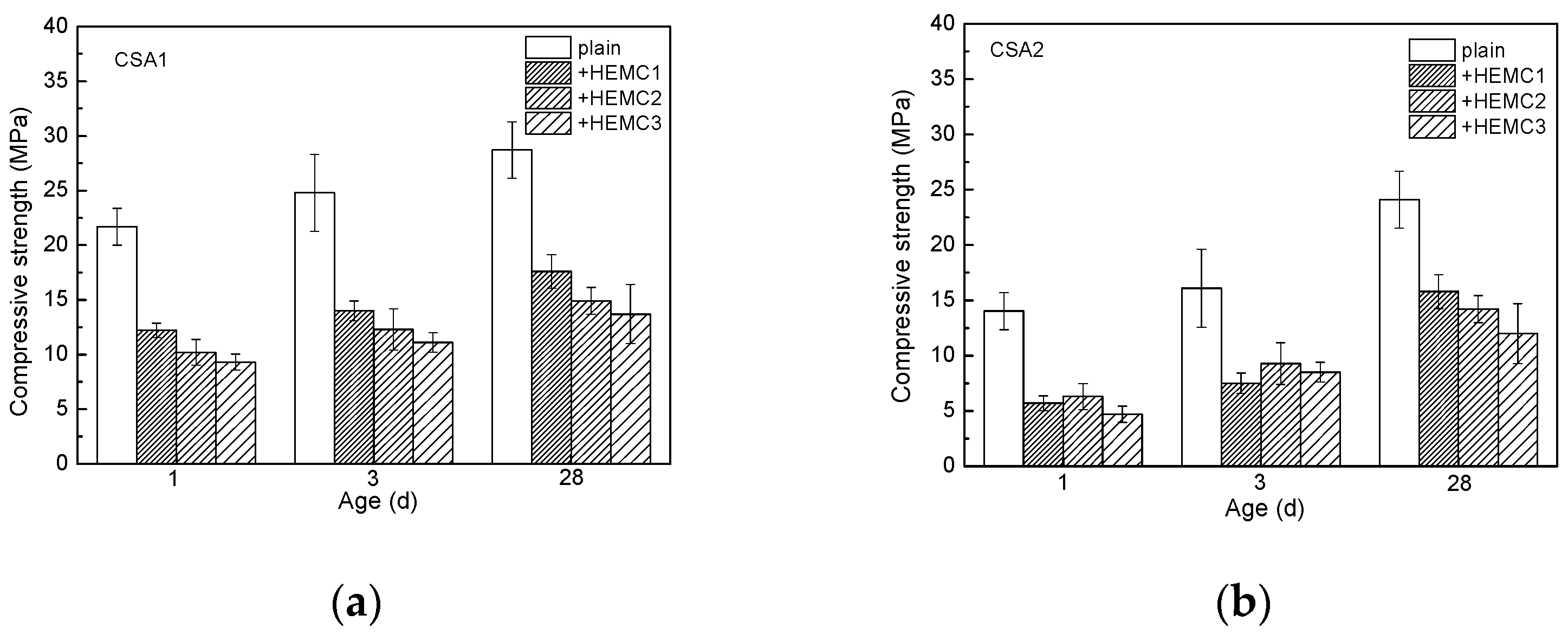
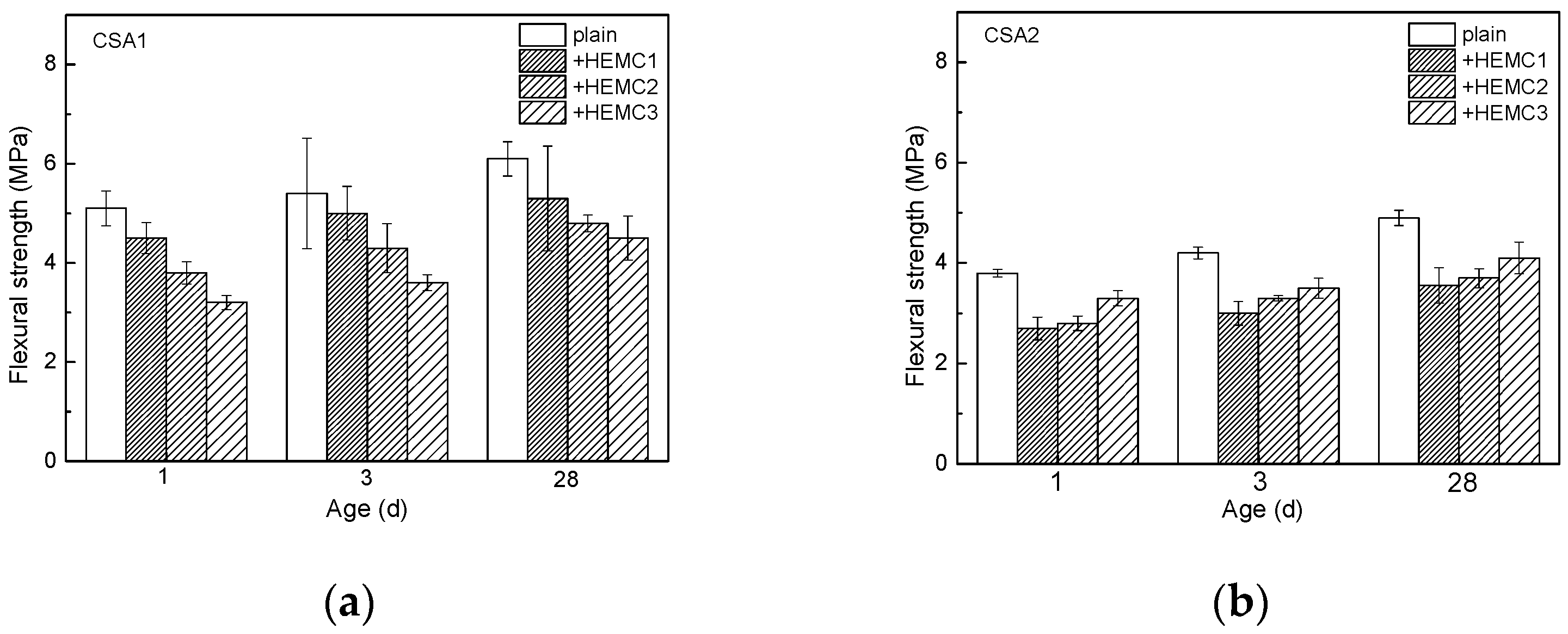

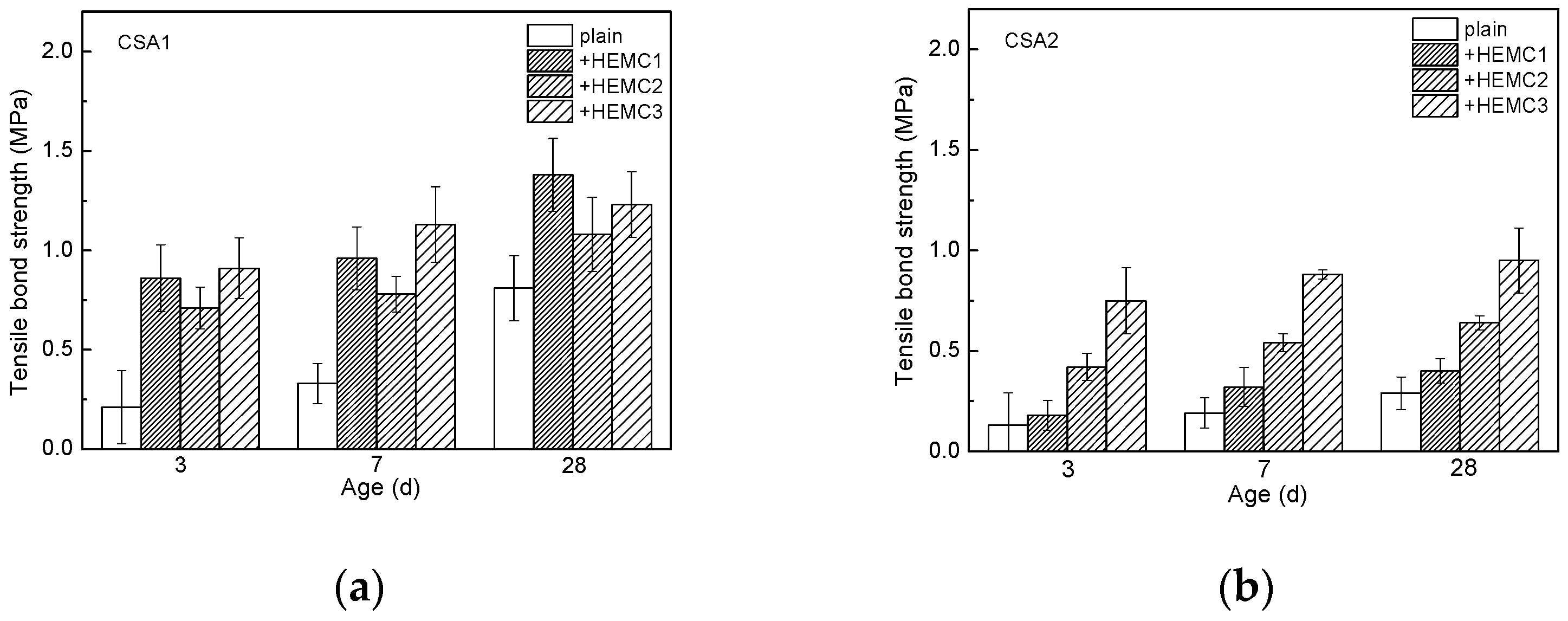
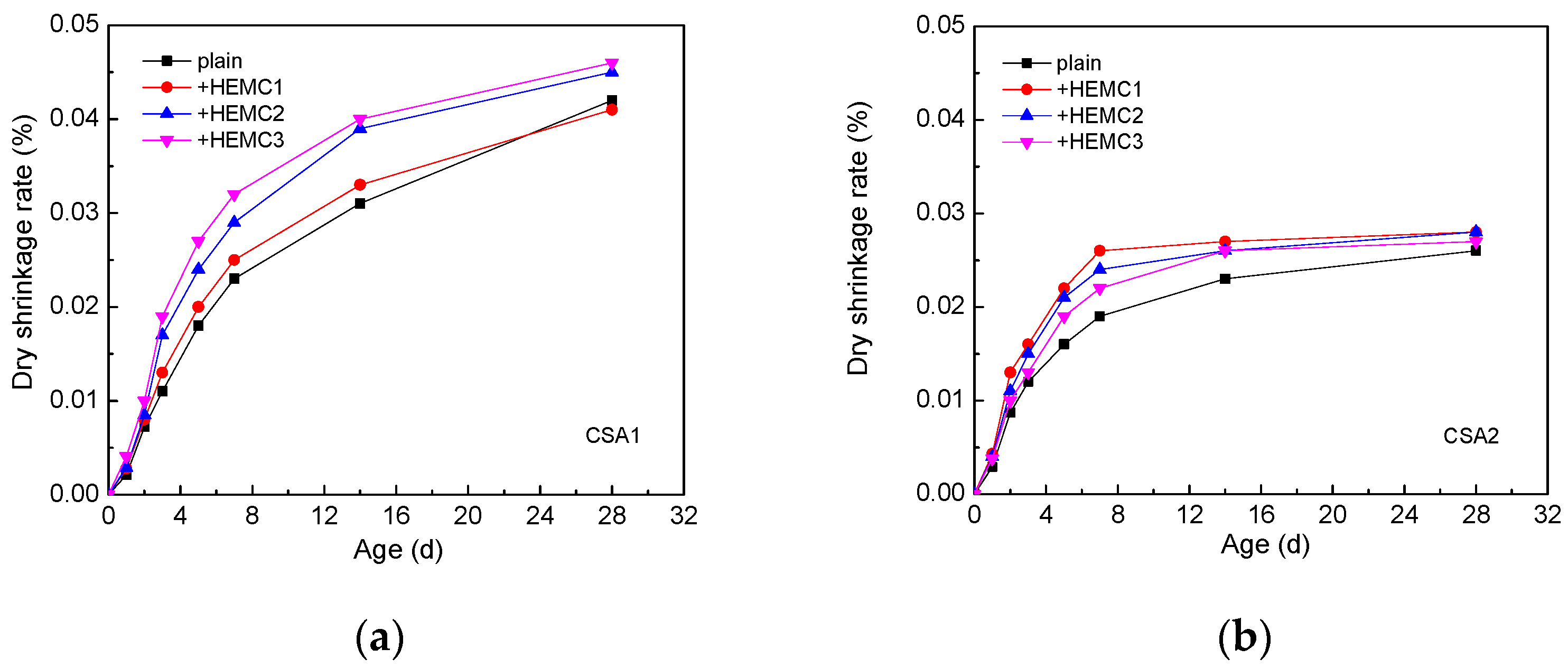

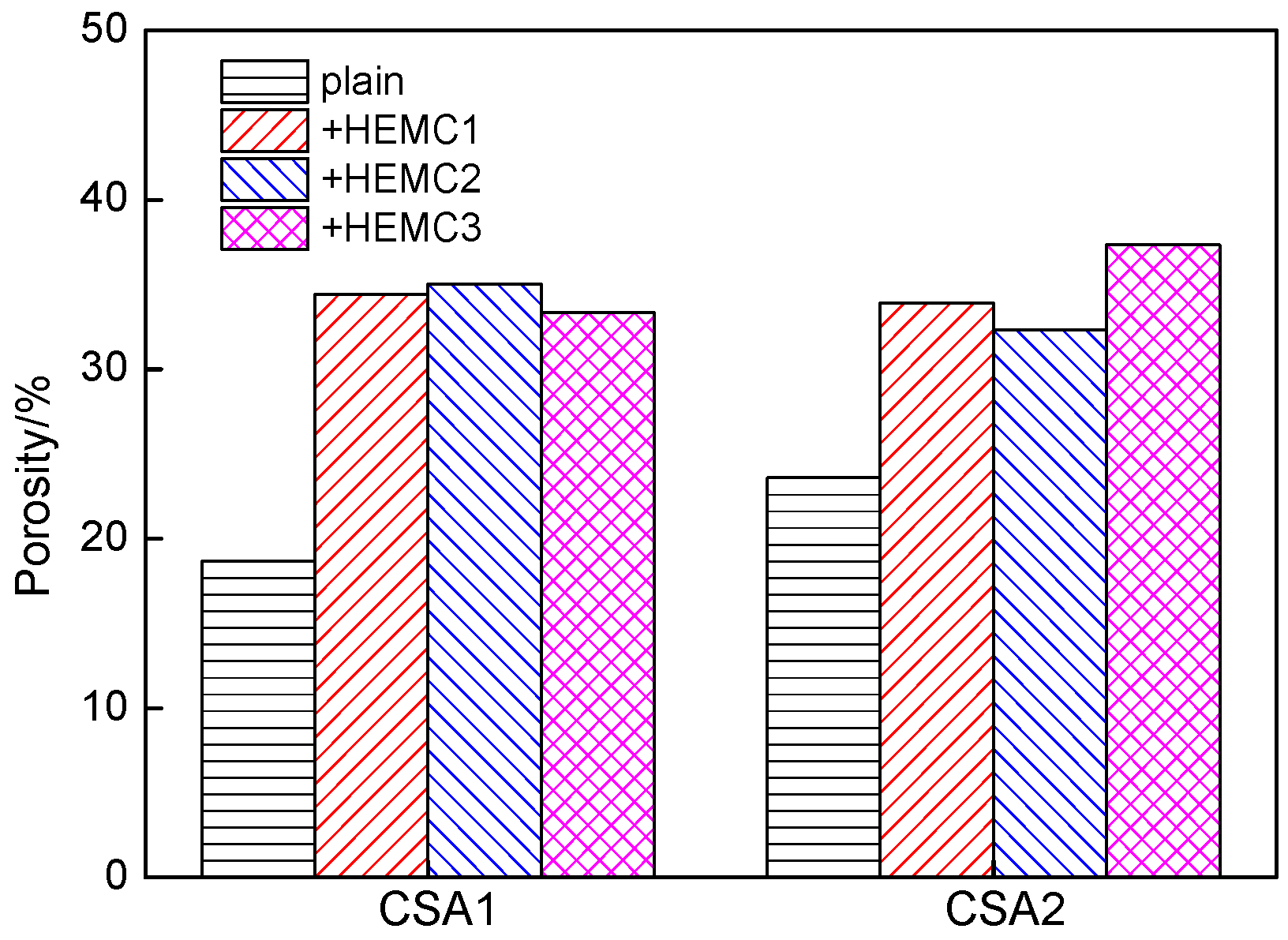
| SiO2 | Al2O3 | Fe2O3 | CaO | MgO | SO3 | Na2O | K2O | TiO2 | P2O5 | |
|---|---|---|---|---|---|---|---|---|---|---|
| CSA1 | 13.00 | 17.80 | 1.90 | 44.90 | 2.66 | 12.60 | 0.11 | 0.41 | 0.94 | 0.16 |
| CSA2 | 18.00 | 13.60 | 2.52 | 44.50 | 3.58 | 13.10 | 0.25 | 0.42 | 0.77 | 0.28 |
| C4A3 | C2S | C4AF | C12A7 | CT | Gypsum | Anhydrite | Amorphous | |
|---|---|---|---|---|---|---|---|---|
| CSA1 | 28.4 | 17.9 | 4.0 | 1.5 | 2.6 | 1.5 | 9.6 | 19.4 |
| CSA2 | 15.7 | 25.1 | 3.5 | 3.6 | 1.3 | 1.9 | 12.4 | 30.0 |
| HEMC1 | HEMC2 | |
|---|---|---|
| Viscosity, 2% solution, 20 °C, Haake RotoVisco (mPa·s) | 35,500 | 39,100 |
| Average fiber width (µm) | 7 | 18 |
| Average fiber length (µm) | 290 | 126 |
| Molecular mass, numbers medium (g·mol−1) | 373,000 | 577,400 |
| Molecular mass, weight medium (g·mol−1) | 742,500 | 759,500 |
| Drying loss (Wt %) | 3.9 | 5.6 |
| Sodium chloride (Wt %) | 2.37 | 2.81 |
| DS | 1.41 | 1.57 |
| Total MS/DS | 1.6 | 1.90 |
| Water Retention Rate/% | Consistency/mm | Fluidity/mm | |
|---|---|---|---|
| CSA1 | 87.0 | 20 | 130 |
| CSA1 + HEMC1 | 99.8 | 38 | 136 |
| CSA1 + HEMC2 | 99.7 | 40 | 142 |
| CSA1 + HEMC3 | 99.9 | 35 | 144 |
| CSA2 | 86.2 | 24 | 122 |
| CSA2 + HEMC1 | 99.4 | 46 | 147 |
| CSA2 + HEMC2 | 99.7 | 34 | 148 |
| CSA2 + HEMC3 | 99.6 | 40 | 147 |
Publisher’s Note: MDPI stays neutral with regard to jurisdictional claims in published maps and institutional affiliations. |
© 2021 by the authors. Licensee MDPI, Basel, Switzerland. This article is an open access article distributed under the terms and conditions of the Creative Commons Attribution (CC BY) license (https://creativecommons.org/licenses/by/4.0/).
Share and Cite
Zhang, S.; Wang, R.; Xu, L.; Hecker, A.; Ludwig, H.-M.; Wang, P. Properties of Calcium Sulfoaluminate Cement Mortar Modified by Hydroxyethyl Methyl Celluloses with Different Degrees of Substitution. Molecules 2021, 26, 2136. https://doi.org/10.3390/molecules26082136
Zhang S, Wang R, Xu L, Hecker A, Ludwig H-M, Wang P. Properties of Calcium Sulfoaluminate Cement Mortar Modified by Hydroxyethyl Methyl Celluloses with Different Degrees of Substitution. Molecules. 2021; 26(8):2136. https://doi.org/10.3390/molecules26082136
Chicago/Turabian StyleZhang, Shaokang, Ru Wang, Linglin Xu, Andreas Hecker, Horst-Michael Ludwig, and Peiming Wang. 2021. "Properties of Calcium Sulfoaluminate Cement Mortar Modified by Hydroxyethyl Methyl Celluloses with Different Degrees of Substitution" Molecules 26, no. 8: 2136. https://doi.org/10.3390/molecules26082136
APA StyleZhang, S., Wang, R., Xu, L., Hecker, A., Ludwig, H.-M., & Wang, P. (2021). Properties of Calcium Sulfoaluminate Cement Mortar Modified by Hydroxyethyl Methyl Celluloses with Different Degrees of Substitution. Molecules, 26(8), 2136. https://doi.org/10.3390/molecules26082136





